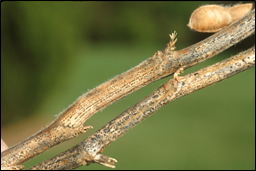Pod and Stem Blight in Soybeans
Pod and Stem Blight
Symptoms
Seeds infected with pod and stem blight produce diseased seedlings that frequently become blighted and die.

Pod and Stem Blight with Anthracnose
University of Kentucky Dept. Plant Pathology
Generally, pod and stem blight is first observed occurring on fallen petioles near the base of attachment or on stems just above petiole attachment.
Tiny black specks (pycnidia) can be observed, usually arranged in rows, on the stems and leaf petioles of older infected plants.
Infected pods will also have scattered pycnidia and pods may be poorly developed. Infected seeds will be shrivelled, cracked, and may be encrusted with a white fungal mass. Seed may be internally infected and show no symptoms.
Pod and stem blight has little effect on crop yield, but seed quality can be greatly affected. The disease is principally of concern to soybean seed producers.
Pod and stem blight can be confused with anthracnose. Warm, humid weather favors the development of both diseases. Occurring late in the season, both diseases frequently occur together on the same plants.
Cause
Pod and stem blight is caused by various specious of the fungi Diaporthe and Phomopsis. The fungi survive the winter in both infected seed and crop residue. Infected crop residue can lead to high levels of pod and stem blight in fields. Seed infection occurs only if pods become infected. Pod infection can occur any time starting at flowering, but extensive seed infections will not take place until plants have pods that are beginning to mature (R7 growth stage).
Damage to pods by insects will favor the development of both pod and seed infections. Early maturing soybean varieties and early plantings tend to be affected more than later maturing cultivars and late plantings. This is because the early maturing and early plantings mature during more disease- favorable conditions than the late maturing and late plantings. Delayed harvest can significantly increase pod and stem blight in both early- and late- maturing cultivars.
IPM Techniques
- Examine plants every two weeks from beginning pod fill to harvest maturity for the presence of pod and stem blight.
- At each site in the field examine two rows of plants 10 feet in length.
- The number of sites you will need to check in each field is based on the field size.
- To determine the number of scouting sites see the field size and number of locations chart.
- Plant high-quality, disease-free seed or certified seed.
- Rotate soybeans with other crops.
- Avoid planting in cool, wet soils.
- Plant late-maturing cultivars, or delay planting of early- and mid- season cultivars.
- Plow under infected crop residue to reduce pod and stem blight in future soybean crop
References and Additional Information
- IPM-3 Kentucky IPM Manual for Soybeans
- PPA-10b Kentucky Plant Disease Management Guide for Soybean by D.E. Hershman, Extension Plant Pathologist
- Compendium of Soybean Diseases, J.B. Sinclair and P. A. Backman (The American Phytopathological Society Press)
Soybean Diseases and Soybean Insects Menu


